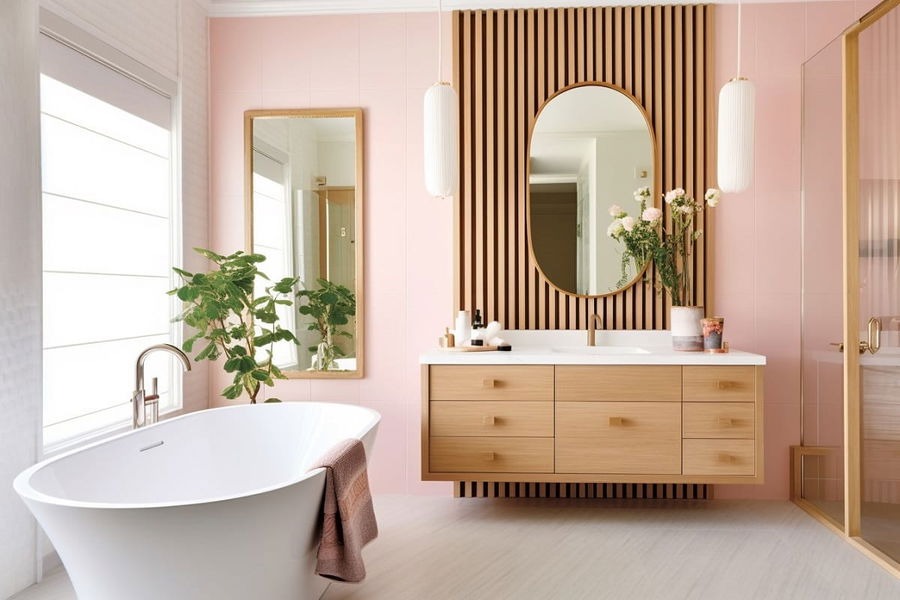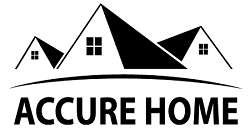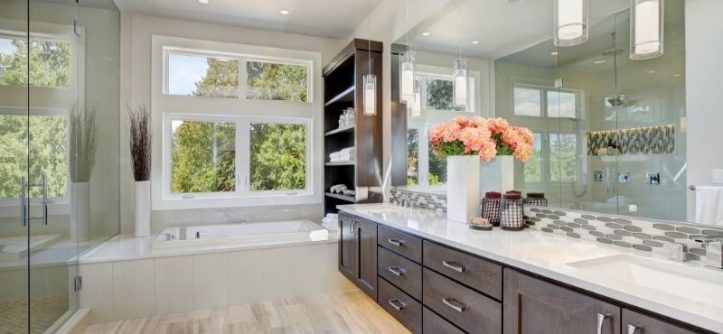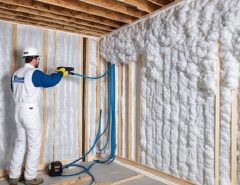Bathroom remodeling transforms your outdated or impractical bathroom into a functional, stylish sanctuary. It involves updating fixtures, layouts, or designs to improve aesthetics, efficiency, and comfort. Whether you’re modernizing an old space or creating a spa-like retreat, a remodel can elevate your home’s value and your daily experience. This process can range from simple updates, like replacing a vanity, to a full overhaul, including plumbing and structural changes. A well-executed project balances beauty, practicality, and budget, tailored to your unique needs. In this guide, we’ll answer common questions about bathroom remodeling, offering expert insights to help you plan and execute your dream space with confidence.
Your Bathroom Remodeling Questions Answered
What Are the Key Steps in Planning a Bathroom Remodel?
Snippet Answer: Planning a bathroom remodel involves setting a budget, defining goals, hiring professionals, choosing materials, and securing permits.
Planning is the backbone of any successful bathroom remodel. Without a clear roadmap, you risk overspending or ending up with a space that doesn’t meet your needs. Start by assessing your current bathroom. What works? What doesn’t? Maybe the lighting feels dim, or the layout is cramped. Next, set a realistic budget. According to the National Kitchen and Bath Association, the average cost of a bathroom remodel in 2025 ranges from $15,000 to $30,000, depending on scope and location. Break this down into categories: labor (40–50%), materials (30–40%), and permits or fees (10–20%).
Define your goals. Are you aiming for a luxurious spa vibe or a practical family-friendly space? Create a mood board with inspiration from platforms like Pinterest or Houzz. Then, decide whether to hire professionals. A contractor, designer, or plumber can ensure quality, but if you’re handy, small DIY tasks like painting can save costs. Research materials early—tiles, fixtures, and vanities vary widely in price and durability. For instance, porcelain tiles are cost-effective and water-resistant, while natural stone adds elegance but requires maintenance. Finally, check local building codes. Permits are often required for plumbing or electrical changes, and skipping them can lead to fines or delays. A detailed plan sets the stage for a smooth project.
How Long Does a Bathroom Remodel Take?
Snippet Answer: A bathroom remodel typically takes 3–8 weeks, depending on the project’s complexity and contractor availability.
Timelines vary based on the scope of your remodel. A simple refresh—swapping out fixtures or repainting—might take 1–2 weeks. A full gut renovation, involving new plumbing, electrical work, or structural changes, can stretch to 6–8 weeks or more. Delays often stem from unexpected issues, like hidden water damage or supply chain hiccups for custom materials. For example, in 2025, global shipping delays for specialty tiles or fixtures can add 1–2 weeks to your timeline. To stay on track, order materials early and confirm delivery dates. Coordinate with your contractor to create a phased schedule: demolition (1–2 days), plumbing/electrical (1–2 weeks), tiling (1–2 weeks), and finishing touches (1 week). Clear communication with your team and a buffer for surprises will keep your project on schedule.
What Are the Latest Bathroom Remodeling Trends in 2025?
Snippet Answer: Top 2025 bathroom trends include smart fixtures, bold tiles, natural materials, and spa-inspired designs.
Bathroom design in 2025 blends technology, sustainability, and luxury. Smart fixtures are booming—think touchless faucets, heated toilet seats, and voice-activated showers. These add convenience and reduce water usage, with some models saving up to 20% on water bills, per EPA WaterSense data. Bold, patterned tiles, like geometric or Moroccan-inspired designs, are replacing plain white subway tiles for a pop of personality. Natural materials, such as wood vanities or stone sinks, bring warmth and texture, while matte black or brushed gold hardware adds sophistication.
Spa-inspired bathrooms remain popular, with features like freestanding tubs, rainfall showerheads, and dimmable LED lighting creating a serene escape. Sustainability is also key—recycled glass countertops and low-flow fixtures appeal to eco-conscious homeowners. If you’re remodeling for resale, neutral tones with modern accents attract buyers, according to Zillow’s 2025 home trends report. Balance trendy choices with timeless elements to ensure your bathroom feels fresh but not faddish in a few years.
How Much Does a Bathroom Remodel Cost?
Snippet Answer: A bathroom remodel costs $15,000–$30,000 on average, depending on size, materials, and labor.
Cost is a top concern for most homeowners. A small bathroom (40–60 sq. ft.) might cost $10,000–$20,000, while a larger master bath (100+ sq. ft.) can hit $25,000–$50,000 or more. Labor is the biggest expense, often 40–50% of the budget, with skilled trades like plumbers or electricians charging $50–$150 per hour. Materials vary widely: a basic vanity costs $200–$500, while a custom one might run $2,000. High-end finishes, like marble or designer faucets, can quickly escalate costs.
To save, consider refinishing existing fixtures instead of replacing them. For example, reglazing a tub costs $500–$1,000 versus $2,000–$5,000 for a new one. Shop sales or opt for mid-range materials like quartz over granite. Hidden costs, like water damage repairs or permit fees ($200–$1,000), can also creep in, so build a 10–15% contingency into your budget. Get multiple quotes from contractors and clarify what’s included to avoid surprises.
Should You Hire a Professional or DIY Your Bathroom Remodel?
Snippet Answer: Hire professionals for plumbing, electrical, or structural work; DIY is best for painting or minor updates.
Deciding between hiring pros and doing it yourself depends on your skills, budget, and project scope. Professionals ensure code compliance and quality, especially for complex tasks like rewiring or re-piping, which require permits and expertise. A licensed contractor can complete a full remodel in 4–8 weeks, while DIY might take longer due to learning curves or mistakes. However, DIY can save 20–30% on labor costs for tasks like tiling or installing a vanity, provided you have the tools and know-how.
Risks of DIY include costly errors—improperly installed waterproofing can lead to leaks, costing thousands to fix. If you’re set on DIY, start small with cosmetic updates like painting or swapping hardware. For major work, hire a contractor with good reviews and proper licensing. Check platforms like Angi or HomeAdvisor for vetted pros, and always get a detailed contract outlining scope, timeline, and payment terms.
How Can You Maximize Space in a Small Bathroom?

Snippet Answer: Use wall-mounted fixtures, light colors, large mirrors, and vertical storage to maximize small bathroom space.
Small bathrooms (under 50 sq. ft.) can feel spacious with smart design. Wall-mounted vanities or toilets free up floor space, creating an airy feel. Light colors, like soft grays or whites, reflect light and make the room seem larger. A large mirror above the sink can visually double the space. Vertical storage, like tall cabinets or floating shelves, keeps clutter off counters. Consider a corner sink or a sliding shower door to save room over traditional setups.
Lighting is crucial—recessed LEDs or sconces brighten without crowding. Pocket doors or barn-style sliders save swing space compared to hinged doors. For tiles, use larger formats (12×24 inches) to reduce grout lines, which can make the floor look bigger. If budget allows, a curbless shower with clear glass panels enhances openness. These tweaks can transform a cramped bathroom into a functional, stylish retreat without expanding the footprint.
What Mistakes Should You Avoid During a Bathroom Remodel?
Snippet Answer: Avoid poor planning, skipping permits, ignoring ventilation, or choosing cheap materials.
Remodeling mistakes can derail your project. Poor planning—like underestimating costs or rushing design choices—leads to delays or regret. Always create a detailed budget and timeline, factoring in a 10–15% buffer. Skipping permits for plumbing or electrical work risks fines or uninsurable damage. Inadequate ventilation, like a weak exhaust fan, invites mold and mildew, which 60% of homeowners face post-remodel, per a 2025 HomeAdvisor survey.
Don’t skimp on materials. Cheap fixtures may save money upfront but often fail within 5–10 years. Instead, invest in durable options like ceramic tiles or brass faucets. Ignoring layout is another pitfall—measure twice to ensure fixtures fit comfortably. Finally, don’t overlook lighting. Layered lighting (ambient, task, and accent) prevents a dim, uninviting space. Avoid these errors by researching thoroughly and consulting pros when needed.
Conclusion: Start Your Bathroom Remodel with Confidence
Your bathroom remodel is an exciting chance to create a space that’s both beautiful and functional. By planning carefully, setting a realistic budget, and choosing quality materials, you can avoid common pitfalls and achieve your vision. Whether you’re adding smart fixtures or maximizing a small space, the right choices make all the difference. Ready to get started? Research local contractors, gather inspiration, and take the first step toward your dream bathroom today. For personalized advice, consult a professional designer or visit home improvement platforms like Houzz for ideas tailored to your style and needs.
Read More Also: What Does ‘Sticky’ Mean in Cooking?
FAQ: Common Bathroom Remodeling Questions
How Do I Choose the Right Contractor for My Bathroom Remodel?
Answer: Look for licensed, insured contractors with strong reviews and a portfolio of similar projects.
Check platforms like Angi or Yelp for ratings, and ask for references. Get at least three quotes, ensuring they include labor, materials, and timelines. Verify licensing and insurance to protect against liability.
Can I Live in My Home During a Bathroom Remodel?
Answer: Yes, but plan for disruptions, especially if you have only one bathroom.
Use a secondary bathroom or set up a temporary shower. Dust and noise are common, so seal off the work area and discuss timelines with your contractor to minimize inconvenience.
What’s the Best Flooring for a Bathroom?
Answer: Porcelain or ceramic tiles are durable, water-resistant, and budget-friendly.
They resist moisture and wear, with prices ranging from $1–$10 per sq. ft. Vinyl is a cheaper alternative ($0.50–$5 per sq. ft.), while natural stone adds luxury but needs sealing.
How Do I Make My Bathroom Eco-Friendly?
Answer: Use low-flow fixtures, LED lighting, and recycled materials.
WaterSense-certified faucets and toilets cut water use by 20–30%. Recycled glass or bamboo vanities add sustainability without sacrificing style.
Do I Need a Permit for a Bathroom Remodel?
Answer: Permits are often required for plumbing, electrical, or structural changes.
Check local building codes. Permits cost $200–$1,000, and skipping them can lead to fines or issues during home sales.
How Can I Add Storage to My Bathroom?
Answer: Use floating shelves, built-in niches, or under-sink organizers.
Wall-mounted cabinets or mirrored medicine cabinets maximize space without cluttering the floor, ideal for small bathrooms.





Leave a Reply